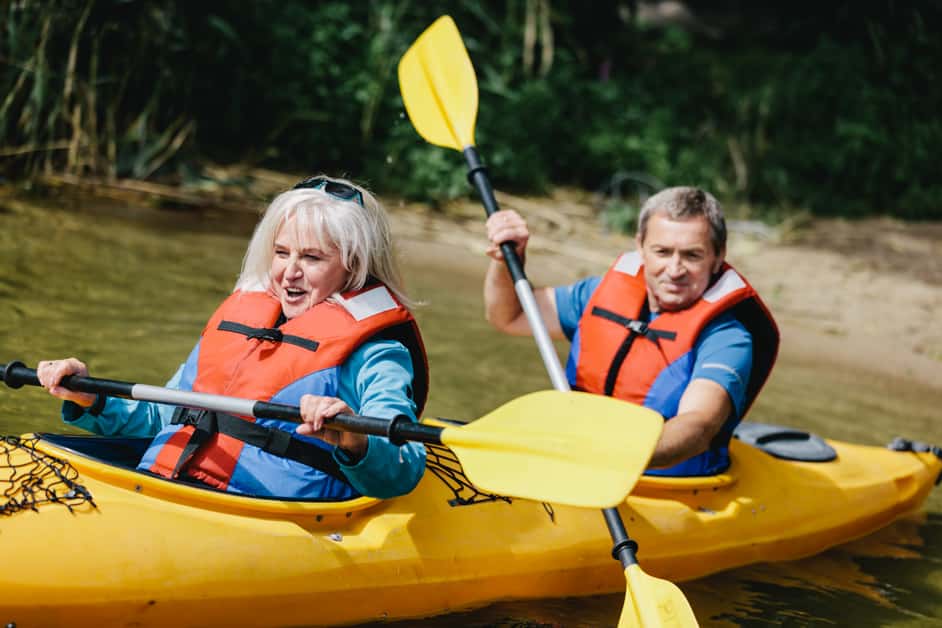Introduction
Knee pain doesn’t have to stop you from getting in shape. Low-impact sports are perfect for those with chronic knee issues, or recovering from a knee injury.
Low-impact sports refer to any physical activity that places little strain on the knees. This includes swimming, biking, yoga, Pilates and light weight lifting. By choosing one of these activities over high-impact ones, such as running or basketball, you can help reduce knee pain and decrease the chances of developing it in the future.
This article will discuss the benefits of low-impact fitness. We’ll explore different types of low-impact sports and provide advice on how to approach them if you have knee issues. We’ll also cover the equipment needed for each activity and give tips on managing underlying knee conditions while being physically active.
Swimming
Searching for a low-impact sport to ease knee pain? Swimming’s your best bet! It builds strength, increases flexibility and won’t give your knees a hard time. Plus, it can be enjoyable! Let’s dive into why it’s so great for folks with knee pain.
Benefits of Swimming
Swimming is excellent for those with knee pain. It offers many rewards, like better heart health, strength, flexibility, and endurance. It’s low-impact, so it won’t strain the joints like running or jogging.
Swimming puts very little pressure on muscles and joints but still improves fitness. It tones the body without the jarring motions of other exercises. The resistance of water makes muscles work harder and increases cardiovascular endurance.
Swimming helps coordination, balance, and agility. It also provides relief for multiple joint pains and strengthens weak muscles. Swimming’s fluid movements reduce stiffness and inflammation, increasing blood flow and aiding recovery.
Tips for Swimming with Knee Pain
Swimming is a great way to reduce knee pain and injury. It takes the weight off your joints, unlike running, jumping or basketball. Here are some tips for swimming with knee pain:
- Warm up in the shallow water before swimming full laps – this will help loosen your muscles and avoid strain on joints.
- If you feel pain during exercise, don’t push yourself. Stop and rest if needed.
- Avoid strokes that require kicking, like breaststroke. Opt for gentle strokes like backstroke or freestyle, to focus on arm movements and reduce pressure on legs.
- Use protective gear like fins to give your arms an extra workout without straining. This is especially important in deeper water, as strong waves could pull your body back without strong kicks.
- Stay determined! Swimming is a great low impact exercise. With practice, you’ll find yourself moving through the water with ease!
Cycling
Cycling is wicked for those with chronic knee pain. It’s a low-impact sport and easy on the joints. You can do it indoor or outdoor and adjust the intensity.
Let’s check out the benefits of cycling for those with knee pain:
- It gives a good workout, without too much pressure on the knees.
Benefits of Cycling
Cycling offers many advantages: improved physical health, mental well-being and stress reduction. It’s a zero-emission form of transport that reduces traffic, fights climate change, and improves air quality. It’s also more affordable than driving or taking public transport.
There are many extra benefits to cycling too, like socializing with other cyclists, exploring new areas, and bonding with family and friends. Group rides can even encourage team building. All in all, it’s an activity with far-reaching benefits and lots of fun!
Tips for Cycling with Knee Pain
Knee pain is an issue for cyclists. But, it can be dealt with. If you have had it in the past or are having it now, these tips will help.
- Bike fit: Make sure your bike’s saddle and stance are correct. Ask a bike pro if needed.
- Exercise and warm-up: Before cycling, stretch and walk. Leg curls and squats can beef up your leg and knee strength.
- Gearing: Have a set of gears suited to your route and terrain.
- Seat tilt: Tilting the seat slightly back helps reduce strain on your knees when going uphill.
- Warmers/guards: Wearing knee protectors can reduce friction and keep you warm. High-quality guards work all season.
Yoga
Yoga is the rage! You won’t strain your joints. It gives a full body workout and helps increase flexibility and core strength. Plus, it may even help reduce knee pain – if done correctly.
Let’s examine the various types of yoga:
Benefits of Yoga
Yoga is key to health and wellbeing, with both physical and mental benefits. Practising yoga regularly boosts flexibility, balance and strength, while calming the mind. It’s low impact and suitable for most ages, making it easy to access.
Breathing techniques in yoga reduce stress by slowing heart rate, calming the nervous system, and bringing relaxation. Focusing on breathing clears negative thoughts and encourages clarity and concentration.
Yoga helps alignment, avoiding strain or injury. Practising yoga makes it easier to spot poor posture, making adjustments before pain or injury happens.
Yoga improves circulation through stretching, providing oxygen to nourish cells and reducing fatigue. This efficient flow boosts physical energy for daily tasks and overall well-being!
Tips for Practicing Yoga with Knee Pain
Yoga is a great exercise for those with joint pain and stiffness. Before practicing, it’s important to know how to approach poses to reduce knee stress. Here are tips:
- Choose standing poses like Warrior II instead of deep forward bends. This can help improve balance and strengthen supporting muscles.
- Stay away from deep twists to avoid further destabilizing the joints.
- Use props like blocks and a wall for support when deep forward folding is necessary.
- Focus on gentle poses to elongate the body and support flexibility. Seated poses such as Child’s Pose or Goddess Pose can help open hips while giving knees a rest.
- Take breaks throughout practice sessions. Listen to your body and come out of poses when needed. You will benefit most from yoga by doing so!
Pilates
Pilates is a superb, low-impact exercise choice for those with knee pain. It aids in developing balance, flexibility, and core strength. Plus, Pilates teaches how to move without worsening current problems. It’s a mix of exercises, stretching, and breathing techniques that can help conquer knee pain and get back to living an active life.
Benefits of Pilates
Pilates is a great form of exercise. It focuses on core strength and stability, coordination, flexibility, and balance. You can do it on a mat or with special equipment like the Pilates Reformer.
Pilates helps build and strengthen your core muscles and improve any imbalances in your pelvis, hips, lower back, and shoulders. It also tones your whole body and helps with posture through proper spine, neck, and hip alignment. By doing small movements to challenge your core muscles, it also increases joint and muscle flexibility.
Pilates is perfect for reducing pain from muscle imbalance syndromes like sciatica and knee pain. It requires concentration and focus on proper form. The low impact targets individual muscles rather than large groups. Plus, focusing on your body’s position promotes mindfulness and self-awareness.
So, if you have chronic pain or want to boost your health, try a Pilates class today!
Tips for Practicing Pilates with Knee Pain
For those with knee pain, Pilates can be risky. But with caution and awareness, it can be beneficial. Listen to your body’s cues and start slow. Here are tips to help:
- Warm-up joints before exercise, especially knees. This increases circulation and lubricates joints.
- Use proper form and alignment. Keep core engaged. Avoid locking or overextending knees.
- Modify exercises until you find one that works best for you.
- Focus on muscle feeling instead of speed.
- Limit tension-building moves, such as single-leg lifts. They can increase stress on a joint.
- Choose movements suited for someone with knee issues. Perform gentle stretches in a slow, controlled way.
Done safely and thoughtfully, Pilates can provide long-term gains and relieve old or existing knee pain.
Conclusion
In conclusion, low-impact sports are the perfect way to stay active without making knee pain worse or risking injury. Swimming, cycling, rowing, and aerobics are great non-contact exercises. Pilates is also a good choice for improving posture and building the muscles that support the knees.
There are so many different low-impact exercises out there – it’s easy and enjoyable to stay fit even with knee pain or an old injury:
- Swimming
- Cycling
- Rowing
- Aerobics
- Pilates
Frequently Asked Questions
Q: What are the top low-impact sports to try to help with knee pain?
A: Swimming, biking, water aerobics, yoga, and pilates are some of the top low-impact sports to help with knee pain. These activities will help strengthen your muscles and joints while taking pressure off of your knees.
Q: What are the benefits of low-impact sports for knee pain relief?
A: Low-impact sports are beneficial for those with knee pain because they help build strength, flexibility, and stability without putting too much pressure on the joints. In addition, these activities can help improve balance and coordination, reduce swelling, and increase range of motion.
Q: Does low-impact fitness help prevent knee pain?
A: Yes, low-impact sports can help prevent knee pain by strengthening the muscles and joints in the area, as well as improving balance and coordination. Regular exercise can also reduce the risk of developing knee pain due to age-related wear and tear.





